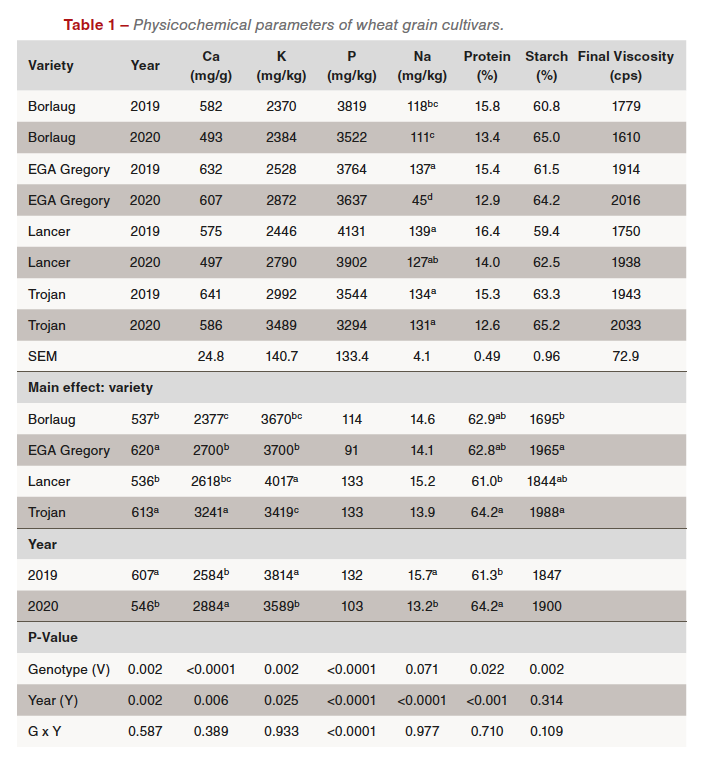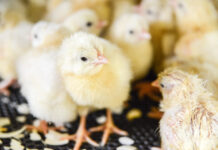
Increasing temperature and consequent changes in climate adversely influence plant growth and development, resulting in loss of wheat productivity. High environmental temperature may influence crops in different ways and such effect varies depending on the crop’s genotype and phenological stages.
A. Khoddami1, V. Messina1, D. Tan1, R. Trethowan1, R. Thistlethwaite1, P. Selle2 and S. Liu1,2
1 The University of Sydney, Plant Breeding Institute, Sydney Institute of Agriculture, School of Life and Environmental Sciences, Faculty of Science, Sydney NSW 2006, Australia
2 The University of Sydney, Poultry Research Foundation, Camden NSW 2570, Australia
The aim of the present research was to study the contributions of genotypes, and year of sowing and their interaction on the physico-chemical quality of wheat cultivars. Four wheat cultivars, EGA Gregory (E), Lancer (L), Trojan (T) and Borlaug 100 (B) were sourced from Narrabri during the 2019 and 2020 growing seasons. Starch, protein, viscosity, and mineral contents (P, Ca, Na and K) were analysed. The data showed that starch, and mineral contents and viscosity were significantly impacted by environmental factor (year) and genotype. However, the interaction of year and genotype did not show any significant changes on the quality of tested grains.
Introduction
Wheat is the predominant feed grain in Australia and other dry regions in the world. Typical broiler diets in Australia contain 60-70% wheat. Climate-induced factors, including elevated temperature, have been reported as depressing crop production around the globe during the last few decades and there is limited understanding of how climate-induced factors may influence the nutritional quality of wheat.
The sowing time of wheat is the most important factor for temperature-sensitive cereals. Late sowing normally depresses grain yield because of the low temperature during germination and the high-temperature stress during the reproductive stage. Moreover, several authors have reported that climate factors such as high temperature or extreme rainfall have a significant impact on the physical and nutritional quality of wheat grains such as grain number, size, grain weight, hardness and the composition of protein and carbohydrate content.
The chemical quality of wheat grain is mainly explored by measuring the content and composition of protein and carbohydrates in response to heat stress. The protein content is increased by heat stress, particularly during the grain-filling period.
Carbohydrate concentration and composition are critical measures of grain chemical quality and have important implications for the functionality of wheat flour. Starch is the main carbon reserve in wheat, which comprises up to 75% of total grain dry weight and heat can inhibit the efficiency of starch biosynthetic enzymes, affecting starch deposition in developing grains. Post-anthesis heat also alters the amylose and amylopectin ratio in grains, which may influence the pasting properties of wheat flour. The aim of the present study was to evaluate the effects of the environment (year), genotype and their interaction on the quality of Australian wheat grain cultivars.
Method
Four wheat grains cultivars (EGA Gregory (E), Lancer (L), Trojan (T) and Borlaug 100 (B)) were sourced from crops grown in Narrabri during 2019 and 2020. The 2019 harvest experienced higher temperatures compared to the grains harvested in 2020. Wheat grains were milled using a Cyclone Sample Mill (UD Corporation Boulder Colorado USA) to a particle size of 500 µm and transferred to a small zip-lock bag, stored in the refrigerator at 4 °C until analysis.
Total starch was measured using an assay kit from Megazyme (K-TSTA).
The total protein content of milled wheat flour was determined using a nitrogen/protein Vario MACRO Cube analyser (Frankfurt, Germany). Thirty mg of samples were prepared in 12 x 6 mm pressed aluminium capsules. Samples were combusted with oxygen and nitrogen oxide. The measured nitrogen content in this method was converted to total protein content by applying a conversion factor of 6.05.
Pasting property was measured using a Rapid Visco Analyser (RVA) (Newport Scientific). 3.5 g of the ground wheat sample was added to 24.5 g of water and ran using 50 °C as base temperature to 95 °C and then back to 50 °C within 13 min cycle.
Mineral content (Ca, K, P, and Na) was analysed using a Perkin Elmer Avio Inductively Coupled Plasma Optical Emission Spectrometer (ICPOES). The results are analysed by two- way ANOVA to check the impact of genotype, year of harvest and G xY interaction.
Results
The starch, protein, viscosity, and mineral contents were determined to check the impact of the year of harvest, genotypes and their interaction (G x Y) (Table 1). The impact of year or genotype was significant on quality attributes of all tested samples. However, the obtained results showed no significant difference in the protein content among different genotypes (P=0.071). The results also indicated that the year of harvest had no impact on the final viscosity of the tested grains (P=0.314).
The starch content increased in grains harvested in 2020 while significantly higher protein content was observed in 2019. The highest level of starch and the lowest level of protein were for Trojan.
The results showed that the genotype remarkably impacted the RVA final viscosity (P=0.002). The greatest viscosity belonged to the Trojan.
The results obtained in the experiments showed that the mineral content level was significantly impacted by all of the factors including, genotype, year and G x Y interaction. Overall, the Ca, Na and P contents increased in the hotter year (2019) while the K content decreased.
Discussion
Regardless of genotype, the average protein content increased significantly in harvested samples in 2019 compared to 2020 samples. The trend is supported by Singh et al. (2021). The starch content was numerically changed among EGA Gregory, Lancer and Trojan. But the starch content was significantly different between the years. The samples from 2019 (hotter year) had the lowest level of starch.
Plant responses to environmental stress (heat) during grain filing led to an increase in total protein content and decrease in starch biosynthesis and a lower grain weight. These changes in the amount and quality of wheat’s major components could be directly linked to different genotypes with different genetic backgrounds.
The exposure of the wheat to heat might impact the protein composition as gliadin production continues at bigger rate than glutenin. This leads to an increase in the level of gliadin and decreases the glutenin content. The heat stress also influences the amylopectin branch chain length and reduces the production of short chain branched amylopectin. The heat stress conditions might also influence the amount of soluble NSP which can affect the viscosity. These changes in the values could later influence the wheat dough pasting property and strength by increasing or decreasing the final viscosity.
Mineral content significantly increased in 2019 with some exceptions. Helal et al. (2022) reported that an increase in mineral content in hotter environment is a mechanism of heat tolerance in wheat. In general, the data shows that heat stress in wheat reduced starch content and increased protein and mineral content.
Acknowledgement: We would like to thank the School of Life and Environmental Science at the University of Sydney for providing the fund and support to run the project.
References are available on request
From the Proceedings of the Australian Poultry Science Symposium 2023

















